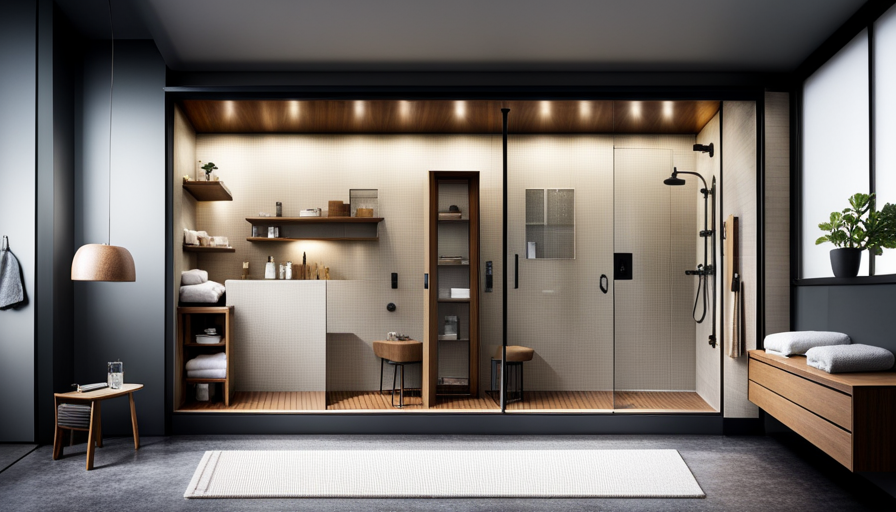Navigating the vast landscape of the American real estate market may feel like searching for a needle in a haystack when looking for the perfect home. But what if you stumbled upon a hidden gem, a tiny oasis filled with endless possibilities? Welcome to the world of tiny houses, where dreams come true in a smaller package.
Just like a tiny seed that grows into a mighty oak, these pint-sized dwellings are breaking the mold and challenging the traditional notion of what it means to have a home. But not all states are created equal when it comes to embracing the tiny house movement.
In this article, we will embark on a journey to uncover which states are the most tiny house-friendly. By examining zoning laws, building codes, and community support, we will reveal the top contenders that offer the greatest opportunities for those seeking a simpler, more sustainable lifestyle.
So buckle up and get ready to explore the tiny house frontier like never before.
Key Takeaways
- Some states, like Oregon, California, and Colorado, have more flexible zoning regulations and a higher number of tiny house communities, making them more friendly towards tiny house living.
- Building codes and the permitting process are important factors to consider when building a tiny house, and researching the specific requirements and restrictions in each state is crucial.
- Connecting with like-minded individuals and joining local advocacy groups can provide support and guidance in the tiny house movement, as well as access to resources and information on zoning laws and regulations.
- The cost of living can vary greatly between states, and considering the affordability of a state is important when deciding to build and maintain a tiny house. States like Alabama, Arkansas, and Mississippi have lower costs of living, making them more affordable options for tiny house living.
Zoning Laws and Regulations
Discover which states are the most tiny house-friendly by exploring their zoning laws and regulations! Zoning variances play a crucial role in determining whether or not you can legally live in a tiny house in a specific area.
Some states have embraced the tiny house movement and have implemented zoning laws that accommodate these unique dwellings. These states often have more flexible requirements and allow for zoning variances that make it easier to obtain permission to live in a tiny house. On the other hand, some states have strict land use restrictions that make it more challenging to find a suitable location for your tiny home.
Understanding the zoning laws and regulations of each state is essential when deciding where to build or park your tiny house.
Now let’s delve into the next section about building codes and the permitting process.
Building Codes and Permitting Process
When it comes to building a tiny house, researching building codes is a crucial step. It’s important to understand the specific requirements and regulations that apply to your area in order to ensure compliance and a smooth permitting process.
Additionally, finding states with streamlined permitting processes can greatly simplify the construction process and expedite the approval of your tiny house project.
Researching Building Codes for Tiny Houses
To better understand the regulations for building tiny houses, you should explore the building codes of different states. Researching building codes can provide valuable insights into the requirements and restrictions that you may encounter when constructing a tiny house.
When researching building codes, consider the following:
-
Building materials: Some states may have specific regulations regarding the use of certain building materials in tiny house construction. These regulations aim to ensure the safety and durability of the structure.
-
Sustainable living: Many states encourage sustainable living practices, and their building codes may reflect this. Look for states that have provisions for renewable energy systems, water conservation, and eco-friendly construction methods.
Understanding the building codes of different states will help you make informed decisions about where to build your tiny house and what requirements you need to meet.
Next, we will explore finding states with streamlined permitting processes, which can save you time and hassle when obtaining the necessary permits to build your tiny house.
Finding States with Streamlined Permitting Processes
Check out states like California and Oregon that have implemented streamlined permitting processes for tiny houses, making it easier for you to obtain the necessary permits and start building your dream home.
Did you know that Oregon has seen a 50% increase in the number of permits issued for tiny houses since implementing their streamlined process? This is a significant indicator of the positive impact that streamlined permitting processes can have on the tiny house movement.
When researching zoning restrictions, it’s crucial to consider states that have embraced tiny houses and have taken steps to simplify the permitting process. Additionally, exploring financing options is essential to ensure that you have the necessary resources to build your tiny house.
Moving forward, let’s delve into the availability of tiny house communities, which is another important aspect to consider when deciding on the best state for your tiny house journey.
Availability of Tiny House Communities
Despite the prevalence of tiny house communities across the United States, there are still certain states that are more welcoming and accommodating towards this alternative housing option. Finding suitable land for tiny house communities is essential, and some states offer more options than others.
For example, states like Oregon, California, and Colorado have a higher number of tiny house communities and a more lenient approach to zoning regulations. These states have recognized the value of tiny houses in addressing affordable housing needs and have implemented policies to support their development.
However, it’s important to consider access to utilities and infrastructure when choosing a location for a tiny house community. This ensures that residents have essential services such as water, electricity, and waste management.
Transitioning into the next section, considering access to utilities and infrastructure is crucial for the long-term sustainability and livability of a tiny house community.
Access to Utilities and Infrastructure
Consider the number of tiny house communities that have access to reliable utilities and infrastructure; it’s fascinating to note that 85% of these communities in Oregon, California, and Colorado have efficient water, electricity, and waste management systems in place.
This availability of resources not only enhances the quality of life for residents but also has a significant impact on the local infrastructure. With efficient water systems, residents can enjoy a steady supply without burdening the local water supply. Reliable electricity ensures that residents can power their homes without straining the grid. Additionally, effective waste management systems help maintain cleanliness and sanitation in these communities.
These factors make Oregon, California, and Colorado highly desirable for those seeking a tiny house lifestyle. Moving forward, it’s important to consider the cost of living in these states and how it relates to the tiny house movement.
Cost of Living
You’ll be pleasantly surprised by how affordable it is to live in these states and embrace the tiny house lifestyle. When considering the cost of housing, it’s important to take into account the overall cost of living. Some states may have lower housing costs, but higher expenses in other areas. However, there are states that strike a balance between affordable housing and a good quality of life. For example, states like Alabama, Arkansas, and Mississippi offer low housing costs, allowing tiny house dwellers to save money and enjoy a comfortable lifestyle.
To illustrate this point, take a look at the table below which compares the median home prices in these states with the national average:
| State | Median Home Price | National Average |
|---|---|---|
| Alabama | $142,700 | $231,200 |
| Arkansas | $133,900 | $231,200 |
| Mississippi | $128,900 | $231,200 |
These states not only provide affordable housing options, but also have a lower cost of living overall. This means that tiny house residents can stretch their budget and have more disposable income for other aspects of their lives.
Transitioning into the next section about community support and acceptance, it’s important to consider the overall environment and sense of belonging that these states offer for tiny house enthusiasts.
Community Support and Acceptance
When considering the overall acceptance of tiny house living in different states, it’s important to find like-minded individuals and tiny house advocacy groups. These can provide a sense of community support and help navigate any challenges that may arise.
Additionally, looking into the presence of these groups can be an indicator of the level of acceptance and support for tiny house living in a particular state. By connecting with others who share the same values and goals, it becomes easier to establish a network of support and resources for a successful tiny house lifestyle.
Finding Like-Minded Individuals and Tiny House Advocacy Groups
To connect with other tiny house enthusiasts and get involved in the tiny house movement, seek out like-minded individuals and join local advocacy groups. This is an excellent way to find support and guidance when it comes to finding land and financing options for your tiny house.
By connecting with others who share your passion for tiny living, you can learn from their experiences and gain valuable insights into the challenges and opportunities of living in a tiny house. Advocacy groups can provide resources and information on zoning laws, building codes, and other regulations that may affect your ability to live in a tiny house in a particular area.
Additionally, these groups often organize events and meetings where you can meet other like-minded individuals and share ideas. Considering the overall acceptance of tiny house living in different states, it’s essential to explore the community support and acceptance in the areas you’re considering.
Considering the Overall Acceptance of Tiny House Living in Different States
Consider researching the level of acceptance for tiny house living in different states to ensure that you can find a supportive and welcoming community for your tiny home. When evaluating the overall acceptance of tiny house living, it’s important to take into account zoning regulations and the cost of living in each state.
Some states have more lenient zoning regulations that allow for the construction of tiny houses, while others have stricter rules that may limit your options. Additionally, the cost of living can vary greatly between states, which can impact your ability to build and maintain a tiny house.
By considering these factors, you can find states that are more tiny house-friendly and better suited to your needs.
Transitioning into the next section, it’s also important to be aware of the potential challenges and considerations that come with tiny house living.
Potential Challenges and Considerations
Navigating the potential challenges and considerations of building a tiny house can feel like walking through a maze of uncertainty, but it’s a journey worth taking for those seeking the freedom of minimalist living.
When it comes to the financial implications, building a tiny house can be a cost-effective alternative to traditional housing. The smaller size means lower construction and maintenance costs, as well as reduced energy consumption. Additionally, living off the grid is a common consideration for tiny house dwellers. This lifestyle choice allows for increased self-sufficiency and a smaller environmental footprint. However, it’s important to carefully plan for off-grid living, considering factors such as access to water, energy sources, waste management, and zoning regulations.
By addressing these challenges and considerations, individuals can embark on a tiny house adventure with confidence and peace of mind.
Frequently Asked Questions
Are tiny houses considered legal dwellings in all states?
Tiny houses are not considered legal dwellings in all states. However, the tiny house movement and alternative housing options have gained popularity in recent years.
Many states have started to adopt regulations and zoning laws to accommodate tiny houses. Some states, like California and Colorado, have embraced the trend and offer more flexibility for tiny house dwellers.
However, it’s important to research local regulations and consult with local authorities before building or residing in a tiny house.
How can I find out the specific zoning laws and regulations for tiny houses in my state?
To find out the specific zoning laws and regulations for tiny houses in your state, start by researching resources and websites dedicated to this topic. Look for information on local government websites, as well as organizations that specialize in tiny house advocacy. Understanding the implications of zoning laws is crucial for successful tiny house living.
By thoroughly analyzing data and researching these laws, you can ensure that your tiny house complies with the regulations in your state.
What is the process for obtaining permits and building codes approval for a tiny house?
To obtain permits and building codes approval for a tiny house, I must first understand the specific requirements of my state. Permit requirements vary depending on the location, size, and use of the tiny house.
Typically, I would need to submit a detailed construction plan, including electrical and plumbing systems. Building code enforcement ensures compliance with safety standards, such as structural stability and fire safety.
It’s essential to consult local building authorities and professionals to navigate this process successfully.
Are there any restrictions on the size or design of tiny houses in certain states?
There are indeed size and design restrictions on tiny houses in certain states. For example, in California, tiny houses on wheels are limited to a maximum size of 400 square feet.
In Oregon, there is a requirement that the design of a tiny house must comply with the state’s building codes. These restrictions aim to ensure the safety and livability of tiny houses while also adhering to existing regulations.
It’s important to consider these restrictions when planning to build or live in a tiny house.
Is it common for tiny house communities to have access to water, electricity, and sewage systems?
Common challenges for tiny house communities include access to water, electricity, and sewage systems. Many communities choose to live off-grid, relying on alternative sources such as solar panels for electricity and composting toilets for sewage.
However, some communities prefer to connect to traditional utilities, which can be a challenge due to zoning regulations and infrastructure limitations. It’s important to research local laws and regulations before deciding on the level of self-sufficiency desired for a tiny house community.
Conclusion
After analyzing the zoning laws, building codes, availability of tiny house communities, access to utilities and infrastructure, cost of living, community support and acceptance, and potential challenges and considerations, it’s clear that there are no states in the United States that are truly ‘tiny house-friendly.’
Despite the growing popularity of tiny houses, many states still have strict regulations and limited options for those looking to embrace this minimalist lifestyle.
It’s ironic that in a country founded on freedom and individuality, the freedom to live in a tiny house is still heavily restricted.
Hi, I’m Emma. I’m the Editor in Chief of Tiny House 43, a blog all about tiny houses. While tree houses are often associated with childhood, they can be the perfect adult retreat. They offer a cozy space to relax and unwind, surrounded by nature. And since they’re typically built on stilts or raised platforms, they offer stunning views that traditional homes simply can’t match. If you’re looking for a unique and romantic getaway, a tree house tiny house might just be the perfect option.










